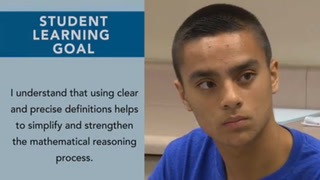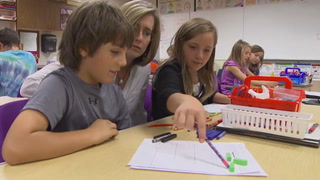Series Formative Assessment Practices to Support Student Learning: Formative Assessment: Proportional Relationships
Math.Practice.MP1
| Common core State Standards
- Math: Math
- Practice: Mathematical Practice Standards
-
MP1: Make sense of problems and persevere in solving them.
Mathematically proficient students start by explaining to themselves the meaning of a problem and looking for entry points to its solution. They analyze givens, constraints, relationships, and goals. They make conjectures about the form and meaning of the solution and plan a solution pathway rather than simply jumping into a solution attempt. They consider analogous problems, and try special cases and simpler forms of the original problem in order to gain insight into its solution. They monitor and evaluate their progress and change course if necessary. Older students might, depending on the context of the problem, transform algebraic expressions or change the viewing window on their graphing calculator to get the information they need. Mathematically proficient students can explain correspondences between equations, verbal descriptions, tables, and graphs or draw diagrams of important features and relationships, graph data, and search for regularity or trends. Younger students might rely on using concrete objects or pictures to help conceptualize and solve a problem. Mathematically proficient students check their answers to problems using a different method, and they continually ask themselves, \"Does this make sense?\" They can understand the approaches of others to solving complex problems and identify correspondences between different approaches.
Math.Practice.MP3
| Common core State Standards
- Math: Math
- Practice: Mathematical Practice Standards
-
MP3: Construct viable arguments and critique the reasoning of others.
Mathematically proficient students understand and use stated assumptions, definitions, and previously established results in constructing arguments. They make conjectures and build a logical progression of statements to explore the truth of their conjectures. They are able to analyze situations by breaking them into cases, and can recognize and use counterexamples. They justify their conclusions, communicate them to others, and respond to the arguments of others. They reason inductively about data, making plausible arguments that take into account the context from which the data arose. Mathematically proficient students are also able to compare the effectiveness of two plausible arguments, distinguish correct logic or reasoning from that which is flawed, and--if there is a flaw in an argument--explain what it is. Elementary students can construct arguments using concrete referents such as objects, drawings, diagrams, and actions. Such arguments can make sense and be correct, even though they are not generalized or made formal until later grades. Later, students learn to determine domains to which an argument applies. Students at all grades can listen or read the arguments of others, decide whether they make sense, and ask useful questions to clarify or improve the arguments.
Math.7.RP.A.3
Common core State Standards
- Math: Math
- 7: Grade 7
- RP: Ratios & Proportional Relationships
- A: Analyze proportional relationships and use them to solve real-world and mathematical problems
-
3:
Use proportional relationships to solve multistep ratio and percent problems. Examples: simple interest, tax, markups and markdowns, gratuities and commissions, fees, percent increase and decrease, percent error.
Save to My Resources
PLEASE CREATE A NEW ACCOUNT OR LOG IN TO ACCESS THIS CONTENT
Enjoy your first video for free. Subscribe for unlimited access.
Have questions about subscribing?
Click Here to learn more about individual subscriptions.
Click Here to learn more about School and Institution access.
Discussion and Supporting Materials
Thought starters
- How does Mr. Elsdon clarify the intended learning for the lesson?
- How does Mr. Elsdon use questioning to guide his students?
- How do the students assess their own understanding?
Teachers
Charles Elsdon
Newest
|
4 MIN
|
5 MIN
|
5 MIN
UNCUT CLASSROOMS
| TCHERS' VOICE
English Language Arts












20 Comments
Kimberly Lair May 22, 2020 12:56pm
Mr. Elsdon uses questions to guide his students because he wants to understand the evidence of his students to clarify and elicit evidence of their learning. His questions are open-ended and require more than a simple answer. He is careful to guide his students with questions because he is interested in what they are coming up with on their own. He walks around taking notes to remind himself where his students are mastering the concepts and where he needs to strengthen his lesson.
Maribel Cordero Apr 6, 2020 1:40pm
How does Mr. Elsdon clarify the intended learning for the lesson? With the whole class Mr. Elsdon reviews the learning goals. The day before he stated he also reviewed the rubric by which they will be graded with.
How does Mr. Elsdon use questioning to guide his students? While eliciting evidence of their learning Mr. Elsdon prods just enough; never wanting to give the next full step. Questions such as where did you get your answer, tell me what you think.
How do the students assess their own understanding? Students were able to create/modify the rubric given to them. This allowed students to have self-accountability. Students also had to provide evidence by demonstrating/stating where they were able to find the answers to their questions. Student use their rubric to score one another. I believe the gallery work allowed students to get a visual representation of evidence.
April White Feb 21, 2020 2:32pm
Mr. Edison clarified the intended lesson by allowing the students to read and understand the learning target prior to starting the lesson and it was visible on their paper at all times. Students were given a rubric and were asked to self-assess and peer assess within their groups. Mr. Edison visited each group at the posters and at their desk to make sure they were on the right track. The students seemed to accept their peers constructive criticism which made learning easier.
Mr. Edison used questioning as he walked around from group to group. This allowed them to use their knowledge to answer his questions on different levels.
The students were able to assess their own understanding through peer assessment and questions ask by the teacher. However, the peer assessment was very beneficial.
cindy conner Apr 19, 2019 10:55pm
Mr. Edison had the students read their learning targets which claried the purpose of the lesson. He guided the students with questioning designed to get them thinking on varied levels. He used multiple techniques and rubrics that led the students to assess themselves and their peers. It was a very effect method of teaching and assessing.
June DiBello Apr 29, 2018 10:21pm